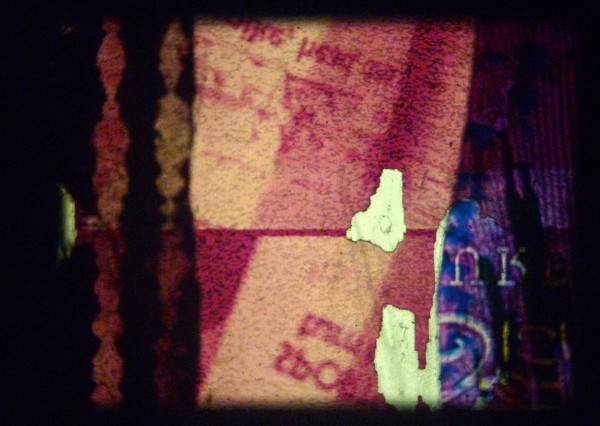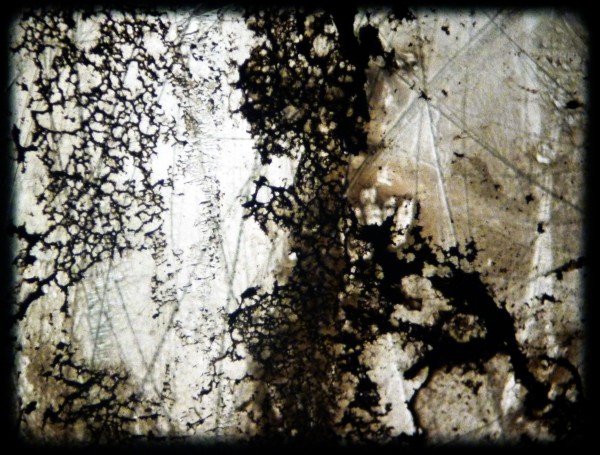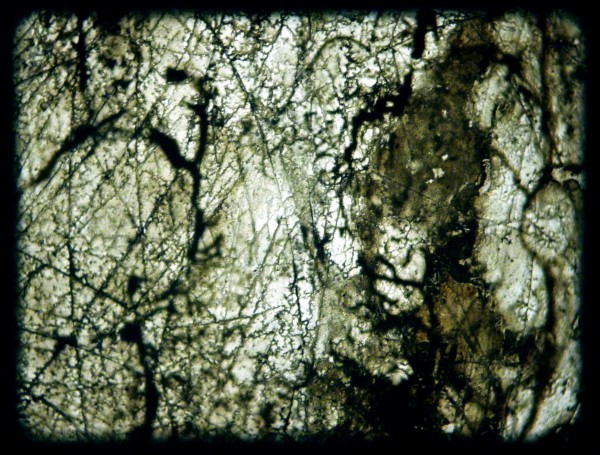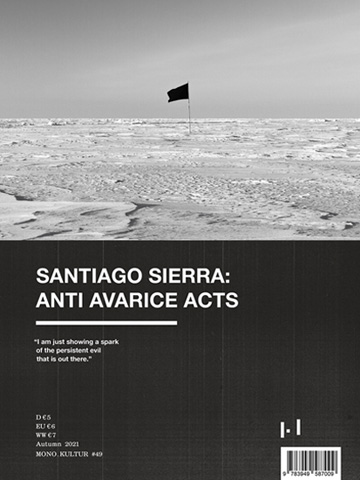
Ricardo da Silva is a founding member of the film collective CINE-NOISE which he describes as “a variable geometry project involving sound artists and experimental film performers.” Through their work and actualizations the group tries “to bring noise music aesthetics into cinema and cinematics into noise music.” Having initially worked in an independent movie theatre where he got his hands on 50s-era projectors and learned to project film, Ricardo developed a broad interest in experimental cinema- he cites the likes of Norman McLaren and Stan Brakhage. A lack of funds and a determination to create visual experiences with scarce means, the artist collected found footage from theaters forced to liquidate old stock as well as projectors. Ricardo and I met in a Tokyo club, in a corner dimly lit by the operation of his projectors, and since then, our correspondence centered on the nature of his visual production and practice.
What do you feel when engaging with the visual culture of the day? Abstract expressionism- as I see it in your work- may allude to intense emotion for one…
Abstract expressionism presupposes that you can have direct access to the material you are working with. Abstract expressionism is hard to achieve if you are working with too much machine-interfaces. I gave more attention to film since it permitted me to get my hands on things, film is a physical place where video is just signal and data flow. Engaging oneself with film at this particular historical moment is swimming against the flow. Supposing you have a cell phone, everyone can make their own film and publish it online and that’s alright because the means are more accessible than ever yet it is all mediated by the interfaces that are brought to you, at your disposal. There’s a mythology within the presumption that open access technology might be hiding something, noting its corporate conditions of production, the corporate controls on the usage you might have of a device and the footprint, for example. In this particular historical moment, technologies are shifting and celluloid film is on the verge of disappearance but this also means that previously high-end and expensive means are much more affordable and/or disposable for free- if you are sneaking into garbage cans. There might be something in this practice like recycling and redemption of our cultural background but you have also to reconsider ways to produce, and find alternatives to produce for less. It’s all cinema povera.
With no acting, no narrative- abstract cinema is still tightly connected to the technicalities of cinema yet emotional works, or experiences are created. Is there a narrative or any central totems to any of your work?
Yes, but very basic ones: what is cinema as a ritual with a start, a climax and an end? Those inner structural and parafilmic schematics are to be requestioned, reconfigured and disrupted. Some usage of found footage implies connectivity to preexisting film culture which is to be reconditioned, fragmented, distorted and blown. But images are signs as well, and through our method of animating in a live setting these images meet the spectator and it becomes open-ended set of emotions. The audience is invited to interpret this unusual animation-form and dive into a kind of visual stasis, a kind of parenthesis to our will to decipher meaning in signs, albeit open-ended rather than dictated, like a meditation. We try to bring the audience to this kind of state of mind by constructing a sense of length, slowly evolving abstract and/or materialistic forms, colors, audio-visual noise patterns built on the fly before your eyes and ears. Abstraction in this kind of performance is intimately combined with the set of cinema: film looping, mechanical movement, lenses and human intervention on the cinema machinery.
How does sound get taken care of- what soundtrack emerges?
Sound is produced within the process of CINE-NOISE : The projectors make noise, the sound lamp-preamp outputs sound from the soundtrack in the film. The projectors produce their own noise when they are working because it’s all mechanical. Some microphones displaced can pick up these noises. But they can also produce sound, because they have a sound lamp and a speaker output. You can also build synthesizers which interact with light. Then you can build on this by passing it through effectors or homemade synthesizers.
How do you respond to different performance spaces?
One of the first performances we made together, back in February 2009, was a visual dispositive that would try to represent some idea of Bentham’s Panopticon, famously de-archived by Michel Foucault. It was a 360° set of simultaneous screenings with eight film projectors beaming scratched or tainted found home movies along with heavy drone music. From that point on we always tried to use multiprojection to reflect a certain wall of images
and the shadows moving along it, and it became the same for sound. Spatially, our idea is to envelop the audience in a whole audiovisual environment.
We’re dealing with an increasing amount of archive- how do you deal with the open-ended limits of visual culture now?
Film is a kind of archive, video and web is another. Access to film archive is truly difficult depending where you are, the country, if there was once upon the time a film production, just home movies or nothing. An open-ended archive is true but rather only in cyberspace, because the support doesn’t matter much and bytes don’t circulate the same way. “There is so much ‘image’ out there now…” is the starting point for a re-action and to take a stance on proposing something different: live enactment of the cinematic creation, it’s unicity, a hard take against mimetism, and a rediscovery of the magic of cinema.

The magic of cinema, what is at the core of the imaginative aspect of CINE-NOISE ?
As we’ve been discussing, the magic of cinema resides in the unicity of a work, live enacted, the open set of emotions you may feel when you are in front of it. There can’t be magic if it’s just plug and play at will. Intimately related to analog technicity, we also try to tie with the original principles behind the machinery : speed, shutter, depth of field, optical trickery, layering, difference and continuity, addition and subtraction.

Cinema, in the traditional sense, continues. More and more films are made and we could take note that Hollywood films, exported around the world, no longer are capable of relating ‘real life.’ Do you see a way today for ‘Cinema’ to co-opt elements of experimental cinema of the last decades?
Cinema has always been a completely made up illusion, a meaning of “generalized hallucination,” as Debord put it, of everyday life. Nowadays maybe even more so because of the progression of computers and the explosion of production budgets which is inherently and inversely related to the scarcity of ideas, at least for mainstream movies. I don’t know exactly how, but I have the impression this is also intimately related to oblivion, cinema as a spectacular form of entertainment hides an ideology of consumption and perpetuation of the socio-economic status quo by alienating the audience from the immediate reality around them.
Sure, I still feel the documentary form demonstrates an ability to relate, reshape and tell realities…histories.
Well, on the other hand, documentary is more focused in a direct approach to reality but things aren’t that clear. It’s not that simple if fiction is fakeness and documentary is truth and are placed in opposition, many filmmakers did and do renegotiate this polarity in several ways- like Michael Moore, Abbas Kiarostami or Pedro Costa, for example. My guess is that there has to be (at least) a third way which involves combining imagination, poetry, materialism and sympathetic politics in the sense explicitly before- oriented through open-ended reception and economically scarce means. However, this question is dubious because it questions the status quo in terms of a polarity between documentary and fiction and it isn’t fully relevant to understand this image-overload all around us. To complete this question, we should also consider the proportions of advertisement, the technologies- and their inherent power structures- embodying all our image culture in our all day life and offer a difference, a regime of signs operating differently even though in the margins. May it be…
For more information on CINE-NOISE, visit www.ricardo.skafka.net

